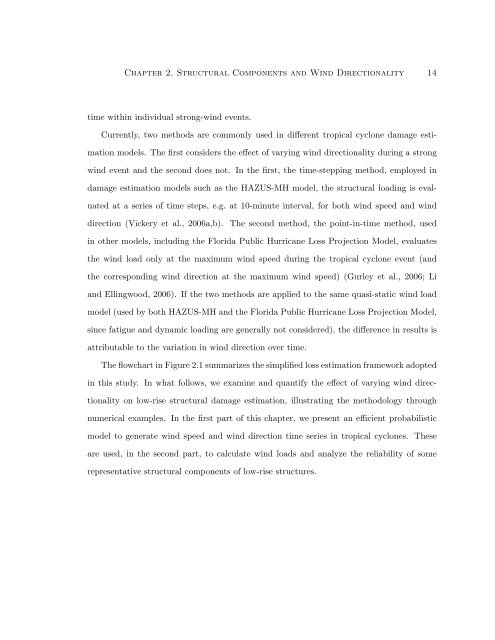Wind Hazard Risk Assessment and Management for Structures
Wind Hazard Risk Assessment and Management for Structures
Wind Hazard Risk Assessment and Management for Structures
Create successful ePaper yourself
Turn your PDF publications into a flip-book with our unique Google optimized e-Paper software.
Chapter 2. Structural Components <strong>and</strong> <strong>Wind</strong> Directionality 14<br />
time within individual strong-wind events.<br />
Currently, two methods are commonly used in different tropical cyclone damage esti-<br />
mation models. The first considers the effect of varying wind directionality during a strong<br />
wind event <strong>and</strong> the second does not. In the first, the time-stepping method, employed in<br />
damage estimation models such as the HAZUS-MH model, the structural loading is eval-<br />
uated at a series of time steps, e.g. at 10-minute interval, <strong>for</strong> both wind speed <strong>and</strong> wind<br />
direction (Vickery et al., 2006a,b). The second method, the point-in-time method, used<br />
in other models, including the Florida Public Hurricane Loss Projection Model, evaluates<br />
the wind load only at the maximum wind speed during the tropical cyclone event (<strong>and</strong><br />
the corresponding wind direction at the maximum wind speed) (Gurley et al., 2006; Li<br />
<strong>and</strong> Ellingwood, 2006). If the two methods are applied to the same quasi-static wind load<br />
model (used by both HAZUS-MH <strong>and</strong> the Florida Public Hurricane Loss Projection Model,<br />
since fatigue <strong>and</strong> dynamic loading are generally not considered), the difference in results is<br />
attributable to the variation in wind direction over time.<br />
The flowchart in Figure 2.1 summarizes the simplified loss estimation framework adopted<br />
in this study. In what follows, we examine <strong>and</strong> quantify the effect of varying wind direc-<br />
tionality on low-rise structural damage estimation, illustrating the methodology through<br />
numerical examples. In the first part of this chapter, we present an efficient probabilistic<br />
model to generate wind speed <strong>and</strong> wind direction time series in tropical cyclones. These<br />
are used, in the second part, to calculate wind loads <strong>and</strong> analyze the reliability of some<br />
representative structural components of low-rise structures.
















